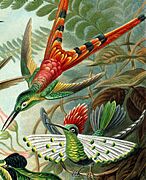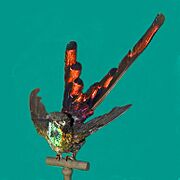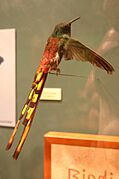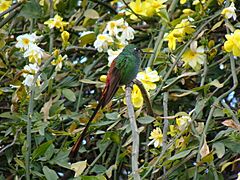Red-tailed comet facts for kids
Quick facts for kids Red-tailed comet |
|
|---|---|
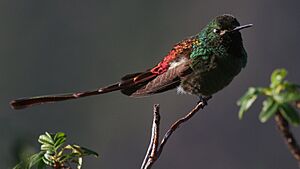 |
|
| Conservation status | |
| Scientific classification | |
| Genus: |
Sappho
|
| Species: |
sparganurus
|
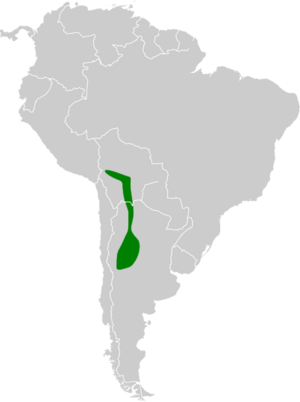 |
|
| Distribution map | |
| Synonyms | |
|
Trochilus sparganurus (protonym) |
|
The red-tailed comet (Sappho sparganurus) is a beautiful, medium-sized hummingbird. It's part of a group of hummingbirds called "coquettes". You can find this bird in countries like Argentina and Bolivia. It might also live in Chile and Peru.
Contents
About the Red-tailed Comet
What's in a Name?
The red-tailed comet was first described in 1812 by an English scientist named George Shaw. Its scientific name is Sappho sparganurus. The name Sappho comes from an ancient Greek poet. The second part, sparganurus, means 'to wrap' and 'tail' in Ancient Greek. This likely refers to its long, wrapped-looking tail.
People in some areas call it Q'ori Kenti in the local Quechua language, which means 'golden hummingbird'. In Argentina, it's known as the picaflor cometa, or 'comet hummingbird'.
How to Identify a Red-tailed Comet
Male red-tailed comets are about 19 to 20 centimeters (7.5 to 8 inches) long. This includes their very long tail, which can be 7 to 10 centimeters (2.7 to 4 inches) by itself! Females are smaller, about 12 to 14 centimeters (4.7 to 5.5 inches) long. These birds weigh about 4 to 6.5 grams (0.14 to 0.23 ounces).
Males have a shiny green head and a bright, golden-green throat patch called a gorget. Their back is reddish-purple, and their belly is mostly green. Their long, forked tail looks reddish-purple to green, depending on the light. The tail feathers have dark tips.
Female red-tailed comets are not as bright as the males and have shorter tails. Their head and back are shiny green, and their rump is reddish-purple. Their throat and belly are pale with small green spots. Young birds look similar to adult females. Both males and females have reddish-brown eyes, a black beak, and black legs and feet.
Where Do Red-tailed Comets Live?
The exact places where the red-tailed comet lives can be a bit confusing, as different experts have slightly different maps. Most agree it lives in Argentina and Bolivia. Some also say it lives in Chile and Peru.
These hummingbirds like to live in dry, mountainous areas. They prefer places with scattered trees, bushes, and dense plants in ravines. You might also find them in special Polylepis woodlands. They usually live at high elevations, mostly between 1,500 and 4,200 meters (4,900 to 13,800 feet) above sea level. Sometimes, they are seen as low as 400 meters (1,300 feet).
Red-tailed Comet Behavior
Daily Life and Movement
Red-tailed comets usually stay in the same area all year. However, in Bolivia, they are known to move to different elevations depending on the season.
What Do Red-tailed Comets Eat?
These hummingbirds mainly drink nectar from flowers. They also eat small arthropods, which are tiny insects and spiders. They can collect nectar while hovering in the air or while sitting on a branch. They catch insects while flying or by picking them off plants. Male hummingbirds often protect their favorite flower patches from other birds.
Reproduction and Life Cycle
We don't know everything about when red-tailed comets breed. In Argentina, they seem to breed from October to December. In Bolivia, it might be from April to June.
Like all hummingbirds, the female builds the nest, lays the eggs, and takes care of the babies. The nest is a sturdy cup made of moss, lichen, and animal hair. It's usually built in a small space on a rock wall, but sometimes in a tree. Females usually lay two eggs. The eggs hatch in about 19 to 20 days. The young birds are ready to fly about 31 to 32 days after hatching. One time, a female was seen starting a second nest and raising more babies even before her first babies had left the nest!
How Do Red-tailed Comets Communicate?
The song of the red-tailed comet is described as a "short, rapid, jumbled chatter." They also make sounds like an "unmelodic tjrrrt" and harsh "tsha" or "zack" notes. These notes can be repeated over and over.
Conservation Status
The IUCN (International Union for Conservation of Nature) says the red-tailed comet is a species of "Least Concern." This means they are not currently in danger of disappearing. They live across a very large area, and even though we don't know their exact numbers, their population seems to be stable. There are no big threats to them right now. They are considered quite common in most of the places they live.
Images for kids



